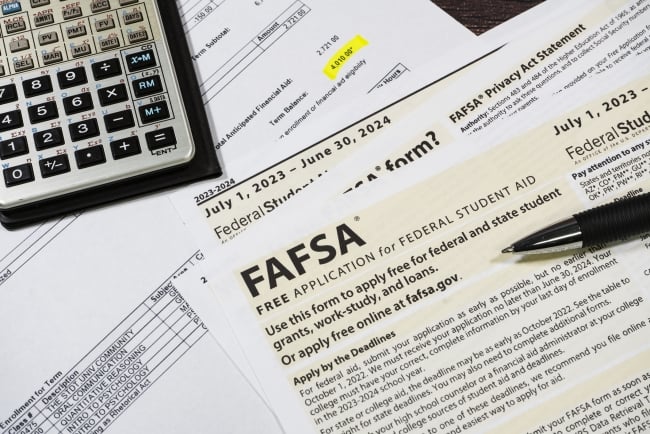You have /5 articles left.
Sign up for a free account or log in.

Delays and technical glitches with the federal aid application reduced the number of students who submitted the FAFSA, requiring colleges and universities to help address the deficit.
Richard Stephen/iStock/Getty Images Plus
The cost of higher education is one of the primary barriers to enrollment for students, particularly those from less privileged backgrounds, including racial and ethnic minorities, first-generation learners, and low-income students, and federal financial aid challenges point to a new additional stressor for these learners.
A recent report by Tyton Partners found around three in 10 students said they waited to re-enroll for the upcoming academic year until they were aware of their federal aid for the next year. Students who previously stopped out of college and re-enrolled were more likely to say this was true (28 percent), compared to their peers who had never stopped out, and they were more likely to consider transfer as a result of delays to last year’s Free Application for Federal Student Aid and modifications (19 percent).
One-quarter of all respondents said their academic performance was negatively impacted by FAFSA-related stress, as well.
New reporting from the Government Accountability Office highlighted how difficult the 2024–25 FAFSA rollout was for new and returning students and emphasized the challenges colleges and universities encountered in supporting student success.
Since the new form’s launch at the end of December, higher ed administrators have thought outside the box to engage learners and ensure all students have equitable access and support to enroll with accurate financial information.
The role of financial aid: Finding ways to pay for college is a concern for both current and perspective students. Tyton’s survey found 41 percent of students felt stress or anxiety regarding their personal finances as a result of the 2024–25 FAFSA delays and modifications.
One 2024 Student Voice survey by Inside Higher Ed and Generation Lab found almost half of current students identified balancing academics with personal, family or financial responsibilities as a top stressor (48 percent), and one-third (34 percent) of respondents identified paying for college as a top stressor.
In a different survey, also conducted this year, a majority of Student Voice respondents (68 percent) indicated they think higher education institutions in general charge too much for a college degree, and around one-third of students believe the general public underestimates the actual cost of a college degree.
In terms of how they foot the bill, a recent study from the American Council on Education showcased how much students depend on financial aid to pay for their education, with 74 of all first-year students expecting to cover some educational expenses using grants, scholarships or military funding. Two in five of these students (42 percent) expected scholarships and grants to cover at least $15,000 of their expenses. Among ACE respondents, seven in 10 students of color and four in five first-generation students expressed at least some concern about their ability to finance their education, highlighting equity gaps.
FAFSA fumble: The GAO released findings about the FAFSA rollout late last month, highlighting the Education Department’s shortcomings when it comes to improving the FAFSA process for many families across the country. One important misstep: The department neglected to inform over 500,000 students of changes to their federal aid estimates, providing inaccurate estimates that informed their enrollment decisions.
Due to the delay, students had about 100 fewer days to complete the FAFSA, which disadvantaged groups that typically rely on community organizers, colleges or others to assist in form completion. Technical barriers led around 1.6 million students to start but not complete the form, as well. An April survey of first-generation college students from Study.com found almost half (47 percent) of respondents were unable to complete their initial FAFSA submission.
Even when students did persist with completing the form, it took the median first-time applicant (filing as a dependent) five days to complete new FAFSA and a returning student 1.3 days, according to the GAO report.
“In prior years, counselors could work with students to complete most of the form in one sitting. However, this year counselors needed multiple one-on-one support sessions with both the student and parents, which were difficult to coordinate,” according to the report. Students filing as an independent had a more efficient process, with the median completion time between 12 and 15 minutes.
FAFSA is delayed again for the 2025–26 academic year to allow for additional testing of the form.
Filed away: To help students understand their federal aid offerings and promote retention, higher education institutions and advocates have implemented strategic measures to highlight FAFSA completion. Such actions, or similar efforts, may need to be continued this year.
- Many colleges have scaled their FAFSA drives to accommodate an influx of question and confusion around the form for incoming and returning students. Texas A&M International University, part of the TAMU system, offered a series of events that allowed students to receive help in person, over the phone or through a virtual appointment earlier this year. The initiative, FAFSA for U, dedicated computer lab space for each session, hosted during working hours once a week.
- Other institutions and groups have established incentives for students who complete a FAFSA. San Diego City College launched an on-campus barbershop that provides free haircuts to any student who has filed a FAFSA, enrolled in at least one class and mapped out their educational plans. The community college hoped to target male students of color with the initiative, because barbershops are often seen as a place for community building and these learners are least likely to access counseling or financial aid services.
- The Southern California College Attainment Network partnered with L.A. Cash for College to provide students a $25 gift card for any learner who attended an in-person FAFSA clinic or booked a virtual appointment.
- To reduce the impact of FAFSA delays, Dominican University in Illinois expanded scholarship dollars for students disproportionately affected by technical challenges. Black students or children of undocumented or mixed-status parents interested in attending Dominican’s Chicago campus received priority for the scholarships.
- The Kentucky Higher Education Assistance Authority decided to put some fun back in funding educational expenses and hosted a 12-hour telethon, which had a live team who answered phones and responded to student and parent questions while also broadcasting live music, games, skits and a dorm room cooking show, among other activities.
- The City University of New York received $1 million in funding from the Petrie Foundation to hire and train peer coaches to support students with questions about the FAFSA and the New York State Tuition Assistance Program. The program hired 24 CUNY students to offer virtual and in-person financial aid support on campuses as well as in public facilities across New York City such as libraries, community centers and high schools.
Get more content like this directly to your inbox every weekday morning. Subscribe here.








